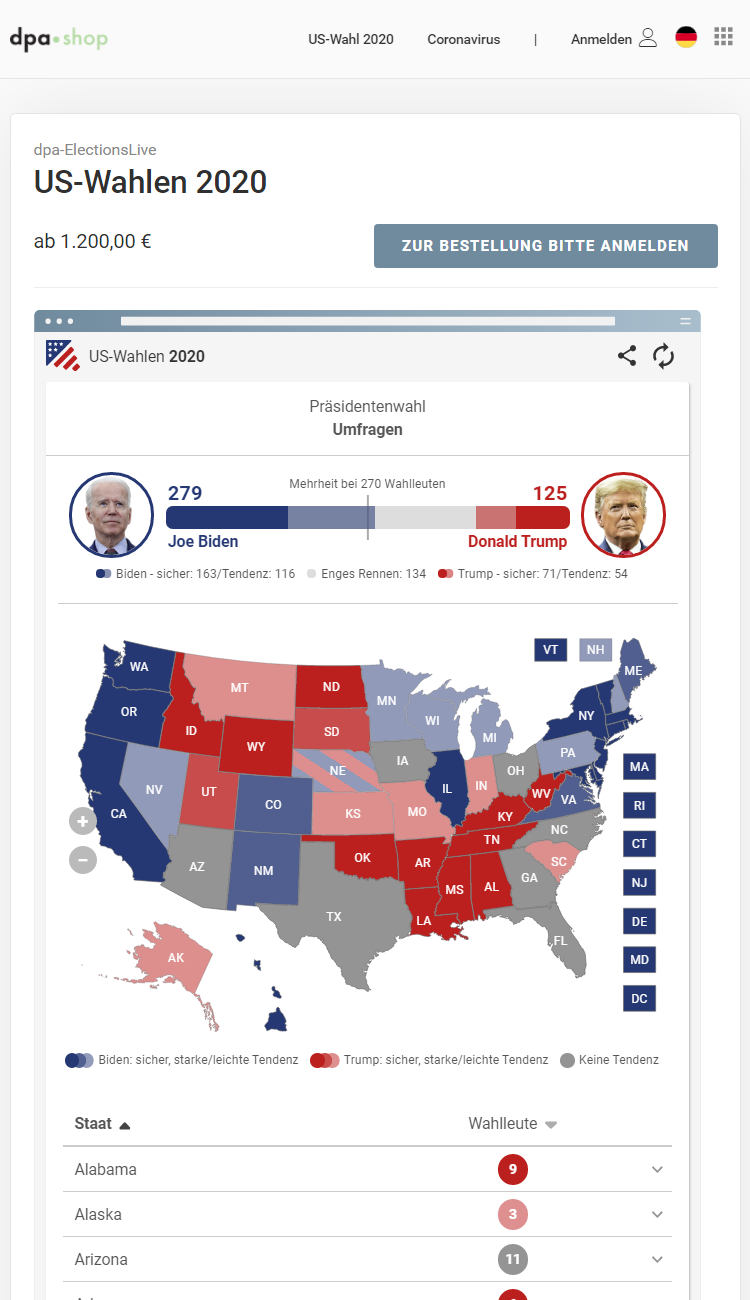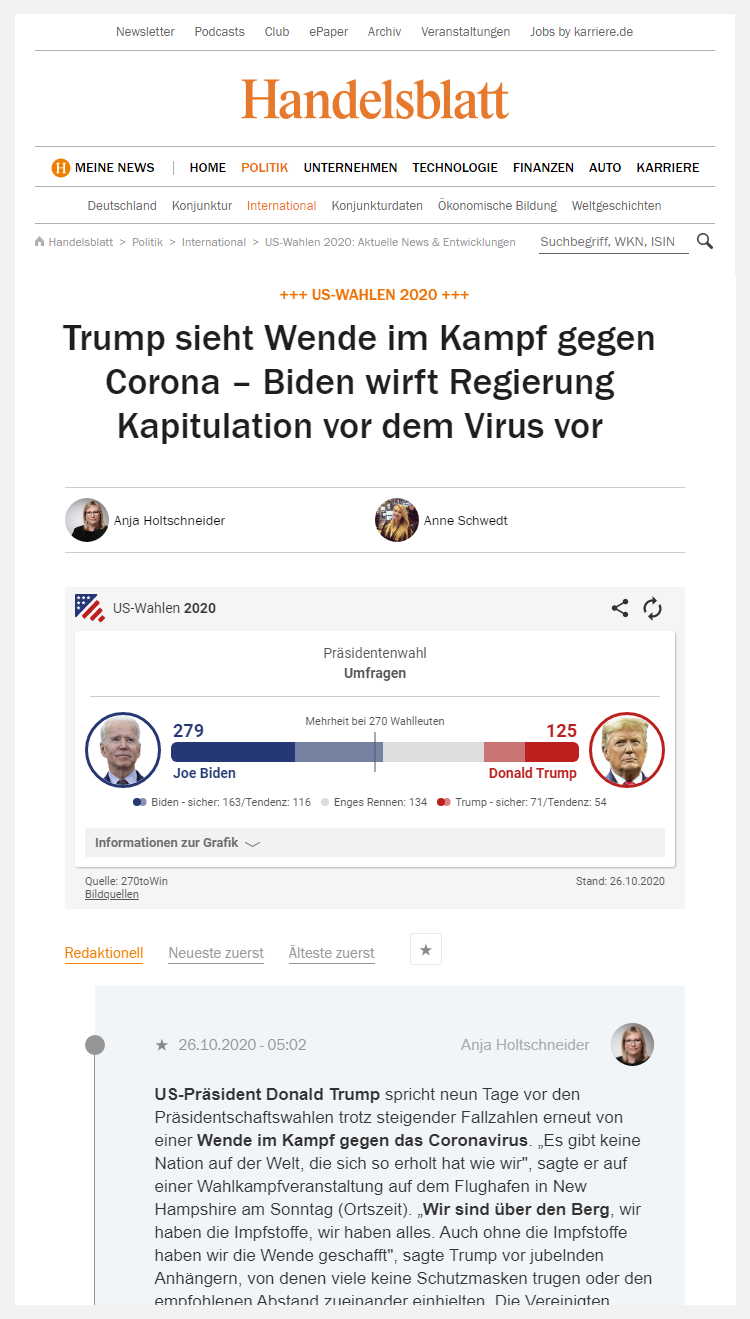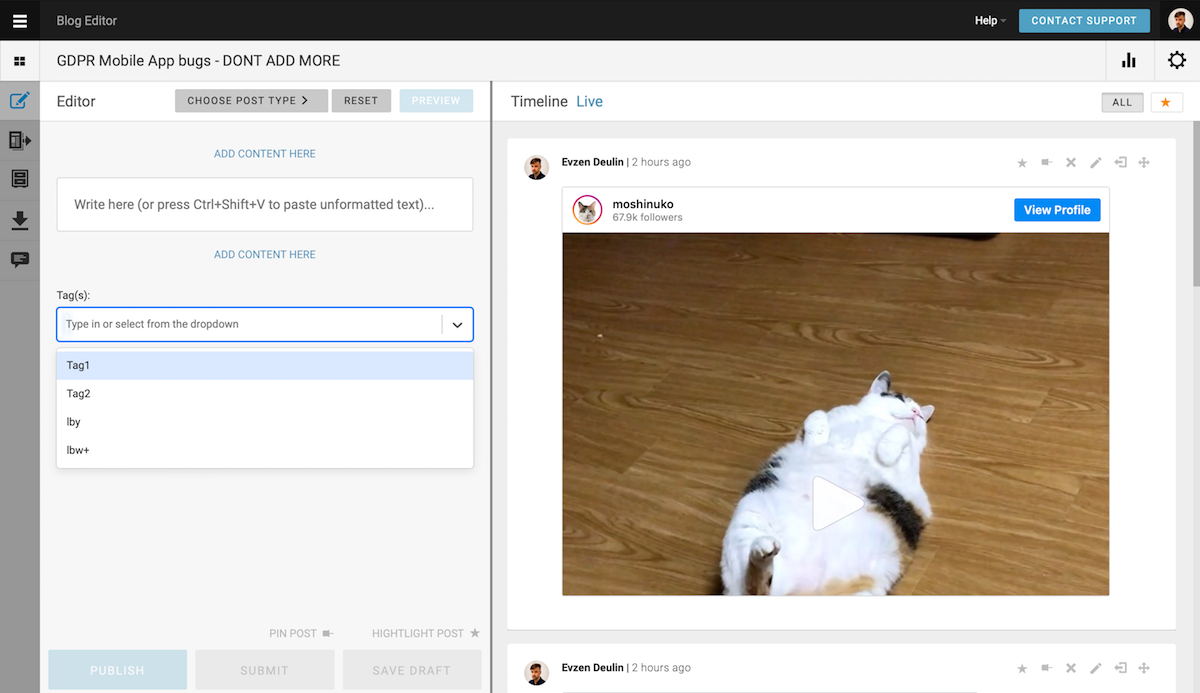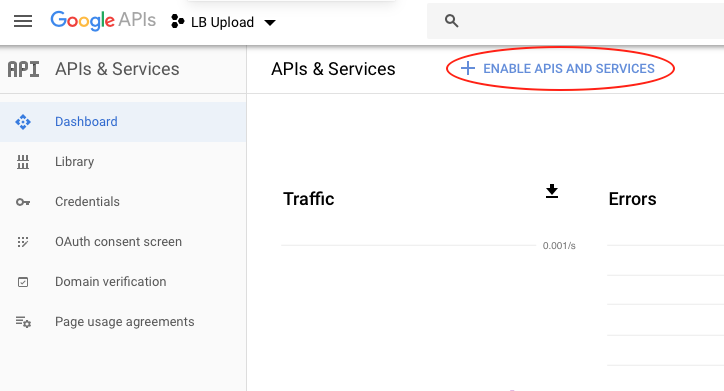by The Live Blog Team | November 25, 2020
November 25, 2020
Using A Live Blog for Black Friday Deals

Using Live Blog for Black Friday Deals
Once Black Friday was only part of the holiday shopping season for retailers. Today it triggers major consumer activity for anyone in the content business: not only when readers make purchases, but also for reading reviews and checking out what the trends and must-have items are for the season. That’s why Black Friday can be a big opportunity for publishers too.
Brands, retailers and news media all benefit from the extra attention that consumers pay to their favourite websites on the last Friday in November in search of deals on the stuff they want to get or gift. Typically those must-have items span a range of categories, from electronics and household goods to makeup and fashion, each offered by a variety of retailers or websites.
Using a live blogging platform as a real-time deal ticker, publishers can present all of the latest promotions in one place. Here are some examples from around the web:
And this year, with brick-and-mortar stores closed or at limited capacity, customers will be doing most of their holiday shopping online. Publishers can benefit from this trend by inking an affiliate or referral agreement with retailers.
How a Black Friday live blog works
A Black Friday live blog is one part editorial curation and one part affiliate marketing.
Publishers can either earn a commission when readers go on to visit a retailer’s storefront from the deals mentioned on the live blog, or sell paid placements directly. Another benefit to publishers’ websites is the increase in traffic. One publisher told us that their Black Friday Live Blog, and the live video that goes with it, boosts traffic by 43% on Black Friday over their daily average of 700,000 daily readers.
Readers not only see it as a service, but also a fun read they enjoy spending time on. In particular, they may appreciate the personal touch added by a blog’s editors.
Live blogging special deals year round
The official week of Black Friday runs from the last Monday of November to the first Monday of December. However, savvy editors start adding the pre-holiday promotions as early as late September for those deal-hunters who never stop searching for the best bargain.
How can Live Blog boost your content monetisation strategy? Get in touch with us for a personal consultation.
October 30, 2020
Using Live Blog to Cover the 2020 US Elections

Using Live Blog to Cover the 2020 US Elections
by The Live Blog Team | November 2, 2020
This year we’ve seen new and innovative uses of our live blogging platform Live Blog for live, breaking news from all of our clients. Many have used it for real-time blogging to cover the COVID-19 pandemic as it has unfolded locally and internationally. Some have used it to document key events in politics. Now both of those use cases are converging in the upcoming US election, which will hinge in large part on the current president’s handling of the coronavirus crisis. US politics are followed closely in Europe because of American influence in foreign policy, economics and other domains.
Below is a gallery of some of our German clients’ Live Blog coverage:
DPA – Deutsche Presse-Agentur
Covering elections is one of the most common use cases for Live Blog thanks to the ability to create an instant timeline with real-time updates.
Die Zeit
Live Blog offers a form of visual storytelling where infographics, photos, videos and charts blend seamlessly together.
Handelsblatt
If you are not yet a Live Blog user and you’re looking for live blogging software to cover real-time news, you can try Live Blog for free here, no strings attached.
October 22, 2020
Introducing Live Blog 3.8.3: New scheduling and sharing features

Introducing Live Blog 3.8.3: New scheduling and sharing features
by Anna Rohleder | October 22, 2020
This year we’ve seen live blogs become an integral part of real-time news coverage. Newsrooms are using them to provide updates on ongoing situations like the coronavirus pandemic, respond to breaking news and engage with their audiences by sharing through a variety of other media.
The new features we have introduced in the latest release of Live Blog are intended to support all of those live blogging use cases and more. Our goal is to give reporters and editors greater flexibility, especially when working across time zones or as part of a remote team.
Plan your editorial coverage
The first new feature in this release is post scheduling. Previously, you could only publish a post at the time you wrote it — which made sense when covering breaking news. But now, as live blogs are increasingly used for scheduled events such as conferences and product launches, editors need to write content ahead of time.
The new post scheduling feature allows you to write a post to be published at any time in the future. Here’s how it works. Create a new post as usual, select “Scheduled” in the lower right corner of the editing window, choose the date and time for publishing in the calendar and save it by pressing Schedule again. (Note: half-hour increments are set as defaults but you can type in a more precise time of your choosing).
Once you press Schedule again, the post will go to the Scheduled posts queue, which you access by selecting the clock icon in the left menu bar. That’s where you go to edit, update or delete the post. Otherwise, there’s nothing else you need to do once the post is scheduled.
Because Live Blog is web-based, neither you nor your computer have to be online for the post to go live.
Engage your audience with Live Blog embeds
The second new key feature in release 3.8.3 is post sharing. With this feature, you can share a Live Blog post to any of the main social media networks by mousing over the sharing arrow or link button in the lower right corner of a post. Choose the icon of the service you want to share the Live Blog post to, and it will show the post you selected as the highlighted image and caption in front of the blog’s timeline. If a reader clicks on the highlighted post, it and the rest of the blog will open in a new tab or window.
Other improvements and updates in this release include:
- New content filtering functionality on the front end to allow users to filter the content according to their interests. This feature can be enabled or disabled from the theme settings screen.
- Improved ad collection rotation on Default SEO and AMP Themes
- Improved commenting feature on AMP Theme
We also fixed a few issues with video uploads to YouTube, Instagram embeds and some button behaviour on the back end.
To see the additions and improvements in detail for this release, go to the Live Blog releases page on GitHub. Want to know more about what Live Blog can do for your news organisation? Get in touch: saas@liveblog.pro.
Looking to check out Live Blog? There is a Live Blog demo waiting for you! Sign up for a 7 day free trial.
July 23, 2020
Live Blog’s New Tagging Functionality for Digital Publishers

Live Blog’s New Tagging Functionality for Digital Publishers
by Todd Jatras | July 22, 2020
The recent release of Live Blog 3.8 introduced a new tagging feature that improves the discoverability of live blogging content for digital news publishers and their readers.
Previously, it was only possible to search on the content within a timeline by three criteria: newest, oldest, and editor’s choice. But editors can now create and apply as many tags as they want to each post as it’s published, making posts within a blog timeline searchable on a granular level.
Readers will now see an additional dropdown menu, labeled Filter Content, that displays all the available tags they can search on. If, to use one example, a reader of a blog on Premier League football was a fan of Liverpool F.C. and was interested only in items relevant to their team, they could pull down the menu, find their team’s name, select it, and the blog timeline would only display Liverpool-related posts.
To create tags to include in a post, go to Live Blog’s General Settings (see image below) and type them into the Global Tags dialogue box. If a term is not already there, you will be given the option to create that tag. These tags are global, and once they’ve been created they will be available to all the different timelines within a publisher’s blogging portfolio.
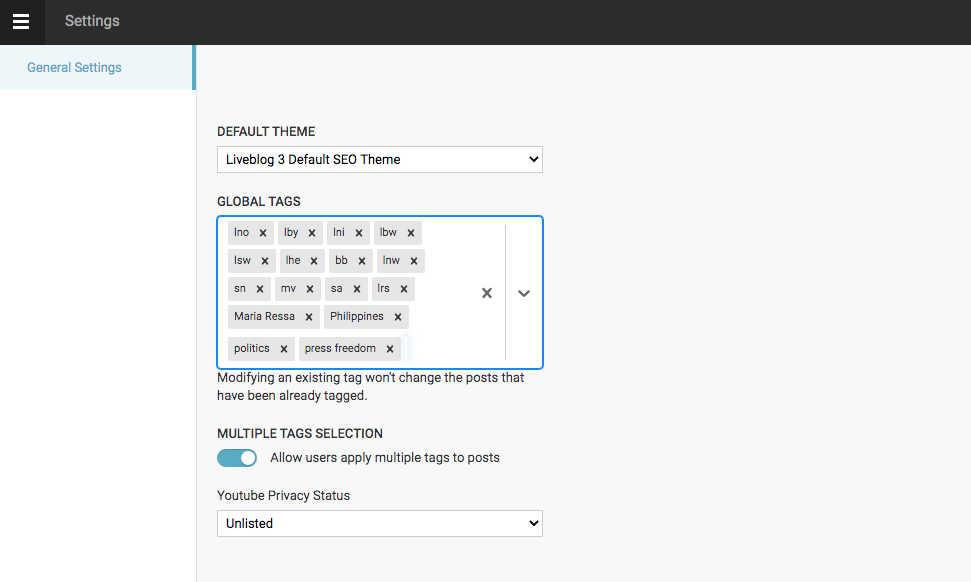
To apply these tags, there is a Tag(s) dialogue box in the editor field, on the bottom of each post. Type in the first few letters of the desired tag, and the predictive text will list available tags below it based on that criteria. In the example below “pr” brought up “press freedom” (highlighted in blue). Select the tag(s) you want, and click update. If the tag you’re looking for is not there, go to General Settings and add it.

When looking at the same post live, from the reader’s perspective (see below), the “press freedom” tag we just created appears under Filter Content.

When the reader selects that tag, only content containing that term will be displayed in the blog timeline.
This new level of search granularity is convenient for both readers, who may be interested in dipping far back into their favourite blog’s archive, and publishers looking to get a better handle on their overall blog content production.
Want to see what Live Blog can do for your publication? Sign up for your free trial here.
July 1, 2020
Live Blog’s New Tagging Functionality: Better Syndication and Content Discoverability

Live Blog’s New Tagging Functionality: Better Syndication and Content Discoverability
by Todd Jatras | July 01, 2020
With the release of Live Blog 3.8, we’ve introduced local and global tagging functionality that streamlines the process of syndicating blog content for news agencies and their clients.
Until now, it was only possible to filter content within a timeline based on three options: newest first, oldest first or editor’s choice. This was useful for readers following a story, but limiting for news outlets looking for posts relevant to their audience. Editors had to wade through what could be a sea of posts to find what they were looking for. But users now have a drop-down menu that displays the list of tags editors have assigned to a specific blog, and can find appropriate content by filtering on these tags.
In addition to global tags that can be applied across Live Blog instances, editors can also create and apply local tags to individual posts within a timeline. Then, using these tags, they can filter content and create syndication channels for news topics based on single or multiple preset tags. (Note: Using global or local tags is an either-or decision; it is not possible to use both at the same time.)

Creating and applying tags across instances or within timelines is now a standard Live Blog syndication feature.
For instance, if an agency is running a live blog on the coronavirus outbreak in Europe, editors could tag each post within that blog timeline according to location or region (Germany, Austria, Norway, etc.) and media outlets in those countries would be able to identify appropriate items by filtering with their relevant tags.
Some of our Live Blog clients, such as German news agency DPA, have dozens of live blogs going at a time, and are constantly adding new ones as big news stories break that require live coverage.
Finding particular topics among all of those blogs was the goal of introducing tag-based filtering in the latest Live Blog release. Now, news agencies and their clients can search across blog instances and within individual blog timelines, and set up more targeted syndication output channels. With an embed link created on the back end of Live Blog, clients will only see the content that has been filtered based on those tags.
If you are not yet a Live Blog user and you’re looking for live blogging software to cover real-time news, you can try Live Blog for free here, no strings attached.
June 15, 2020
How to publish Tweets to your Live Blog with just one click

How to publish Tweets to your Live Blog with just one click
by Gregory Bruno | June 15, 2020
With social media the preferred outlet for newsmakers to break news, journalists today need easy ways to share these digital morsels of information with their audiences. One common tactic – trawling Twitter feeds, copying embed codes, and pasting this data into a news organisation’s website or blog – is time-consuming and inefficient.
With Live Blog, this process can be automated. Here’s how:
If you don’t have a Live Blog account, you’ll need one to get started. Visit Liveblog.pro to sign up for your free seven-day trial.
Now that you have a Live Blog instance, the first step is to create an account at Integromat, a free service that connects apps and automates workflows.
Once you’ve created an account, log into Integromat and follow the steps below. Parts I and II of this setup will configure Integromat to connect Twitter with your Live Blog account so that you can easily monitor someone’s Twitter activity from within the Live Blog dashboard. Part III will show you how to publish tweets to your Live Blog timeline.
Setup Part I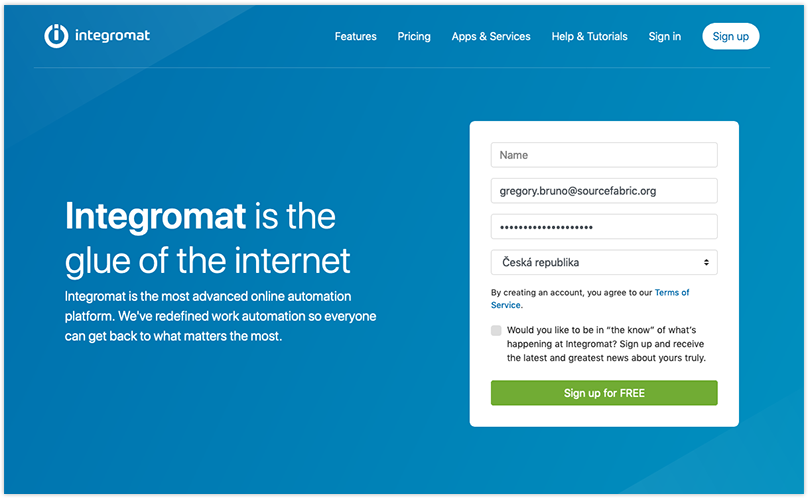
- Click the “Create a New Scenario” button in the top right corner of Integromat.com. This will bring you to a page where you can set up your first module. To do that, type “Twitter” in the search bar. Once you’ve selected Twitter, hit “Continue.”
- On the next screen you’ll see the dashboard for the scenario you’re going to create. Click on the question mark (“?”) and select, “Watch Tweets.”
- Now you need to permit your Twitter module to watch tweets using your newsroom’s Twitter account. Do this by adding a connection, naming it, and then by clicking “Authorise.”
- We want to configure Integromat to watch “Someone Else’s Tweets;” pull the dropdown menu to do that.
- Now, enter the Twitter handle, or “Screen Name,” minus the @ symbol, of the account you want to ingest into Live Blog. Select “Return Full Text of Tweets,” and then choose how many tweets you want Integromat to ingest at a time. You can choose any number you want.
- Finally, you need to tell Integromat when to start ingesting tweets. You can choose any date in the past or from now on.
Setup Part II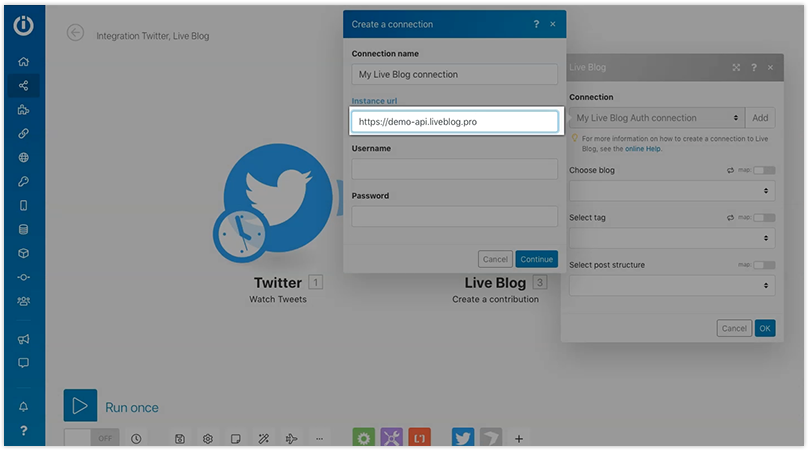
With your Twitter module established, the second step is to configure Integromat to connect this module to your Live Blog account. To do that, follow these steps:
- Click on the half-bubble to the right of the newly-created Twitter module, select the “+” button, and type “Live Blog.”
- If you don’t see Live Blog as an option, click on this link, add the scenario to your account, refresh the page, and then try again.
- Once you’ve selected Live Blog, you’ll be prompted with a window of choices; select “Create a Contribution.”
- Next, you’ll be asked to set up a connection between your Live Blog module in Integromat, and your Live Blog account. To do that, click the “Add” button, create a connection name – it can be anything – then add the URL for your blog. Importantly, you must add “-api” to make the URL work. [Example: https://demo–api.liveblog.pro]. This tells Live Blog that a third-party app is trying to connect.
- Enter your username and password.
- If your Live Blog instance has more than one blog associated with it, the next window will prompt you to choose a specific blog to connect to.
- You can ignore the “Select Tag” box, but below that you must enter a value for “Select Post Structure.” Pull that dropdown window and select “Twitter Post.” Here, you will once again need to input the “Screen Name” of the Twitter account that you are following.
- Finally, in the “Tweet ID” box, you need to provide the identification that we are getting from the blue module. Click the blue “Tweet ID” box, and the field will auto populate. You can ignore the “Autopublish” box.
- Click “OK.”
- Now, establish the intervals that Integromat will pull content from the Twitter account you’re watching. Set that by clicking the “Clock” icon.
- Once you’ve established the connection in Integromat, click “Run Once” to start feeding tweets into your Live Blog from the selected Twitter account.
- Finally, be sure to click “Save.” If you want to watch another Twitter account in your Live Blog editor window, you’ll need to create another scenario by repeating Parts I and II.
Setup Part III
Now, let’s see what all of this looks like in Live Blog.
On the left side of your Live Blog editing panel, click the “Contributions” button. Inside this pane is where all of the tweets fetched from the account or accounts that you are watching will appear. When you want to publish a tweet to your blog, simply push this “Publish” button, and it’s done. If you want to remove a tweet to keep this pane organised, click “Remove.”
Once you publish, you can see what it looks like by clicking “Live” next to “Timeline” at the top of your editing window.
And that’s it. With this integration, you’ll never again need to switch between windows or copy embed codes to share a newsmaker’s tweets with your audience. Everything you need to post quickly is now right in the editing screen of your Live Blog.
May 26, 2020
Live Blog Examples: Great Use Cases for Blogging Inspiration

Live Blog Examples: Great Use Cases for Blogging Inspiration
by Todd Jatras | May 26, 2020
Live blogs are a key editorial format used in newsrooms around the world to provide continuous, real-time coverage of important events as they happen.
Whether it’s scheduled events such as sports matches, elections, product launches and cultural events, or unpredictable occurrences such as severe weather and disasters, terror attacks and political unrest, a live blog’s curated timeline format allows news organisations to quickly break a story, then provide frequent updates after it’s been published and syndicated.
This go-to form of storytelling has seen an unprecedented surge in usage this year as the coronavirus pandemic emerged, and news sites scrambled to keep up with the rapidly evolving crisis. The advantage of using a live blog to cover such an important story is that it provides a dynamic, centralised repository where writers and editors can collaborate on quick-fire updates while effortlessly incorporating rich multimedia formats and posts from all the social media platforms. Readers also prize the format as they know exactly where to return to get the latest updates.
In this post we discuss a variety of live blogging use cases separated out by the most popular categories or story types. We’re including examples from our own customers as well as other live blog examples from around the web that best illustrate the potential of the format.
Elections and Politics
Live Blog is the perfect journalistic tool for covering elections with up-to-the-minute updates as they come in.
- See how Passauer Neue Presse used our live blogging platform to cover the spring municipal election in Bavaria;
- Norwegian online news site Nettavisen used it to report City Council meetings in Oslo, thus boosting reader engagement while increasing local government transparency.
Politics isn’t limited to elections and legislative debates, however. Court cases and judicial proceedings also lend themselves to live blogging. This live blog of orders and opinions issued by the United States Supreme Court shows how a curated timeline of official updates from the bench, interspersed with expert commentary, can provide insight into an otherwise obscure arm of government.
For more tips, see this guide to optimising elections coverage, which shows you how to use custom post types, image slideshows and advanced features for charting and live poll reporting.
Sports

Sporting events are particularly well-suited to live blogging because of the timed-play nature of most popular games, like football. Avid fans often will keep a live blog open while watching a game on television, looking to the blog repeatedly in second-screen mode throughout an event for the latest replays, statistics and play-by-play commentary from both experts and fans.
For some examples of how top news agencies as well as small media outlets are live blogging sporting events, see:
- Tagesspiegel’s Bundesliga football coverage
- Independent sports blog AthleticsAfrica uses Live Blog to report on African athletes, with an emphasis on track and field, road running and cross country.
True fans are eager for as much information as they can find on their favourite teams, and players when they’re off the field. Player transfers are an example of a sporting event other than a game that lends itself to live blogging, such as this one run by The Standard in the UK. Live blogs that include custom post types for player transfers make it even easier for fans to keep track of who is headed where, and how teams are shaping up for the season ahead.
Meanwhile, video gaming or esport events are becoming more popular, as are blogs covering them. For an example of how Live Blog was used for a global esports tournament, see dpa and Morgenpost’s team coverage of the 2018 ESLOne event in Hamburg.
Weather and Natural Disasters
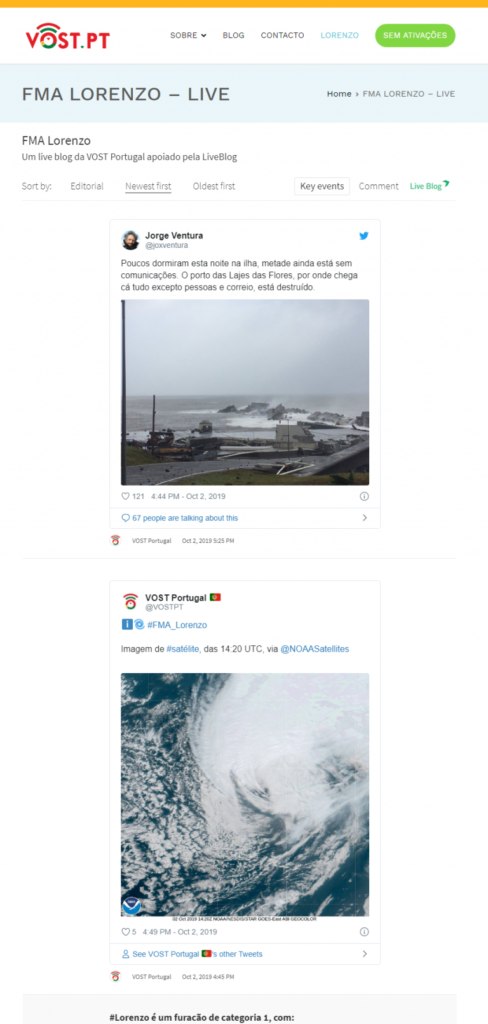
When disasters strike, providing readers with the latest, up-to-the-minute information is crucial, and can even be life-saving.
In the context of the coronavirus pandemic, this case study outlines how German-language news outlets such as Austria Presse Agentur (APA), Zeit Online and dpa have been using our live blogging software to deliver continual updates to their readers.
Other use cases from our customers include:
- the Nepali Times coverage of the 2015 Earthquake in Nepal
- how VOST.PT tracked Hurricane Lorenzo as it approached the Azores archipelago in 2019
- DPA’s coverage of the June 2019 European heat wave.
Cultural Events
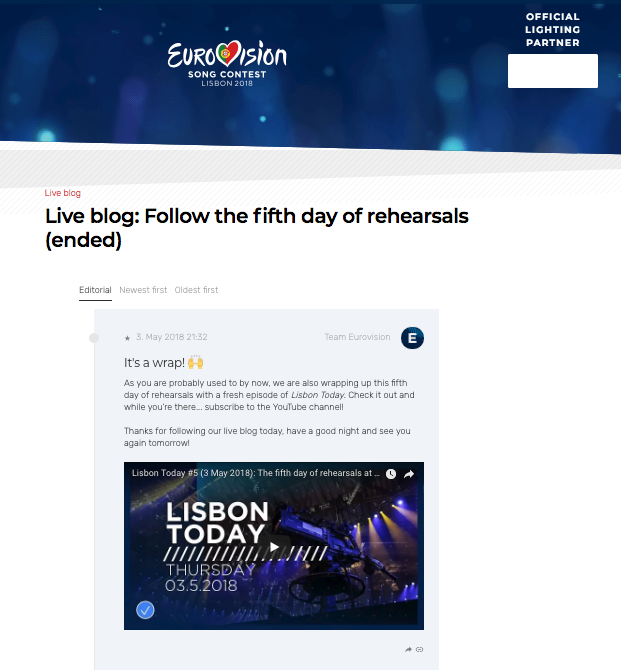
Awards ceremonies, festivals, concerts and art events are prime occasions to live blog and provide readers with a sense of being in attendance. This guide to Live Blogging a Cultural Event is a good place to start thinking about how to set your coverage apart.
Other Live Blog examples include dpa’s live blog on the 2020 Grammy music awards in Los Angeles, and Eurovision’s coverage of its 2018 Song Contest, one of the largest TV events in the world.
War and Terror Attacks
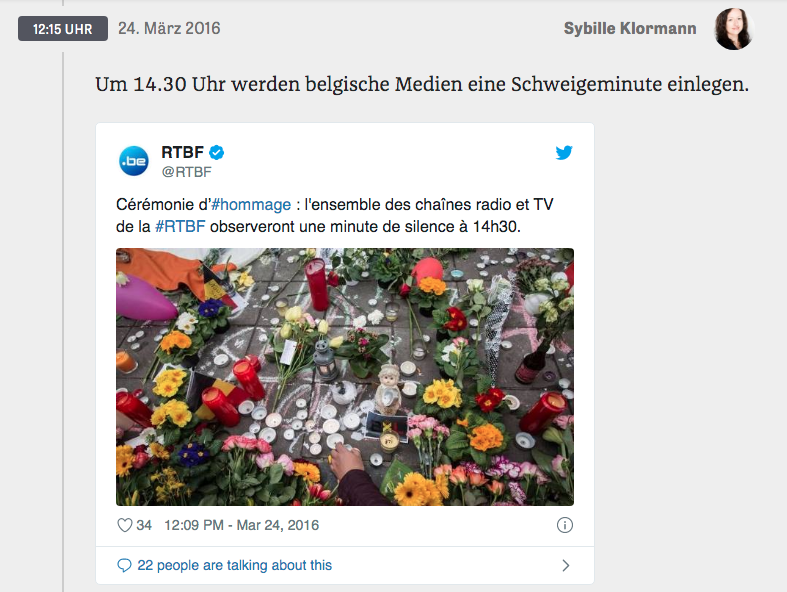
German news site Zeit Online used Live Blog for extensive coverage of the 2016 terror attack on Brussels and experimented with what they call a “slow blog” on the years-long reporting on the Battle of Mosul. We interviewed Sybille Klormann, lead editor for all live blogging projects, to learn about Zeit Online’s best practices for this dynamic form of real-time coverage.
The Environment

As climate change drives a variety of other crises, reporting on the environment has become more urgent; many news organisations are devoting significantly more time and resources to the subject.
Ambiental Jalisco, a startup network of local news sites in Mexico focused on getting citizens involved in ecological issues in cities across the country, is using our live blogging platform to bring their news and social networks together. Read our case study on Ambiental Jalisco here.
Business

Live blogging is a practical way to track earnings releases and product launches as well as the daily gyrations of international stock markets and individual business sectors.
DPA used Live Blog to report Apple’s 2019 Keynote, highlighting all of the company’s new product releases as they were being announced. Ars Technica has also live blogged Apple launch events.
Elsewhere, CNBC creates a new market-related live blog each day, frequently updating it and pulling together the top stories affecting U.S. stock markets.
Travel and Lifestyle

With so many travel and lifestyle blogs in the digital world, finding a way to differentiate your content and speak to an audience is key. One of our picks for creativity combined with authenticity is W42St, an independent lifestyle magazine that chronicles the people and businesses of NYC’s gritty Hell’s Kitchen neighbourhood. When the coronavirus pandemic hit, they were forced to suspend their print edition, and turned to Live Blog as a way of keeping their community connected.
Weird News, Photo of the Day and Other Offbeat Stories
Finally, the live blog format offers a way for publishers to package content and earn revenue on new products; especially using recurring, daily news features so that customer news organisations can receive it via syndication and readers can easily find it with content tags.
DPA’s Top Photo of the Day is a good example of this. Also, their Weird News & Other Offbeat Stories is currently embedded in around two dozen customer websites, including Mitteldeutsche Zeitung and Radio Essen.
Elsewhere, Reuters has a blog called Oddly Enough that collects and syndicates daily offbeat and humourous stories to their clients.
If you are not yet a Live Blog user and you’re looking for live blogging software to cover real-time news, you can try Live Blog for free here, no strings attached.
April 28, 2020
Introducing Live Blog 3.8: Full GDPR Compliance

Introducing Live Blog 3.8
by Todd Jatras | April 28, 2020
We understand that our clients take privacy and the security of their readers’ personal data very seriously. With the release of version 3.8, Live Blog now has built-in GDPR (General Data Protection Regulation) compliance that is simple to activate.
Websites from the 27 countries that form the European Union are required to collect consent from each reader to their GDPR-compliant data privacy policies. First-time visitors arriving on a Live Blog will see that all social media embeds (Twitter, Facebook, Instagram and YouTube) on the post are shielded with a placeholder prompting them to read the site’s privacy policy and a consent button. This shield effectively blocks said social media platforms from receiving the end user’s information until they provide their GDPR consent.
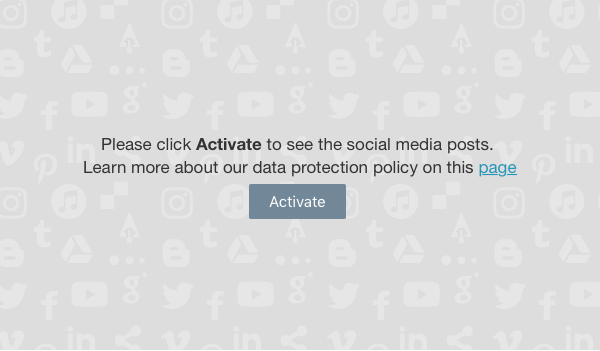
Upon agreeing to the GDPR privacy statement, all social media embeds within the blog will load and become visible. This one-time consent agreement will be saved and applied for each user to all parallel live blogs on that site.
Additionally, the text of the consent agreement is configurable for each site, and can be customised according to various blog themes with links to their respective data protection policy. With the introduction of GDPR compliance, readers now have control over the personal data they want to share.
Improved syndication features in Live Blog 3.8
Our live blogging platform now has a new tagging functionality that supports syndication of specific topics or kinds of coverage in news by labelling and filtering content in the following ways:
- Add single or multiple tags to blog posts
- Filter content based on specific tags through Syndication
- Create output channels that deliver content based on certain tag(s)
Additional improvements
We have introduced a new process for deleting live blogs whereby they are not deleted right away but only after 3 days. Blogs marked for deletion are put in a separate tab for review, allowing users to retrieve blogs they may have deleted by accident.
We also have a new Global Settings section to manage Live Blog’s general configurations.
To see the full rundown of 3.8 features, as well as a complete list of bug fixes and performance improvements for this release, visit Live Blog on GitHub. If you have any questions about the latest updates to Live Blog, contact us: saas@liveblog.pro
March 26, 2020
How To Upload Videos to YouTube Directly from Live Blog

How To Upload Videos to YouTube Directly from Live Blog
by Todd Jatras | Mar 26, 2020
There are many reasons why you should be using videos in your live blogs, chief among them is providing readers with a fuller, visual perspective on the story at hand. Adding videos to your timeline also has an immediate impact on SEO efforts, as search engines tend to give a higher ranking to pages containing rich media, which in turn drives higher organic traffic and reader engagement. Our live blogging software gives you the option to do exactly that.
With that in mind, our recent release of Live Blog 3.6 included the ability to link your blog to a YouTube account and set it up to simultaneously upload videos there as you post them to your timeline.
Read on for a step-by-step guide to linking your Live Blog and YouTube accounts in five easy steps.
Step 1:
First, to set this up successfully, you will need to have administrative access for your Live Blog instance. You also need to have an active Google/YouTube account. Since Google own Youtube, you must have a Google account to set up Youtube. If you don’t already have an account, go to google.com and register for one, then sign in and go to https://console.developers.google.com/.
Step 2:
On the top left-hand side of this page (see below), pull down the “Select Project” menu and click “NEW PROJECT”. In the “Project name” field, give your project an easy-to-remember name like “LB YouTube”, then click the “CREATE” button.

Step 3:
On the Google console page, click “+ENABLE APIS AND SERVICES” (below), which takes you to the API Library page. Scroll down the page and select “YouTube API v3”, then click the “ENABLE” button.
Step 4:
Now go to Credentials under APIs & Services (see below), click the “+CREATE CREDENTIALS” menu at the top of the page and select “OAuth client ID”. For application type, select “web application”. In the “Authorized redirect URLs” field, enter the redirect URL for your Live Blog instance (example: https://demo.liveblog.pro/api/video_upload/oauth2callback) and click the “CREATE” button. Do not include a backslash on the end of the URL or you will receive an error message.
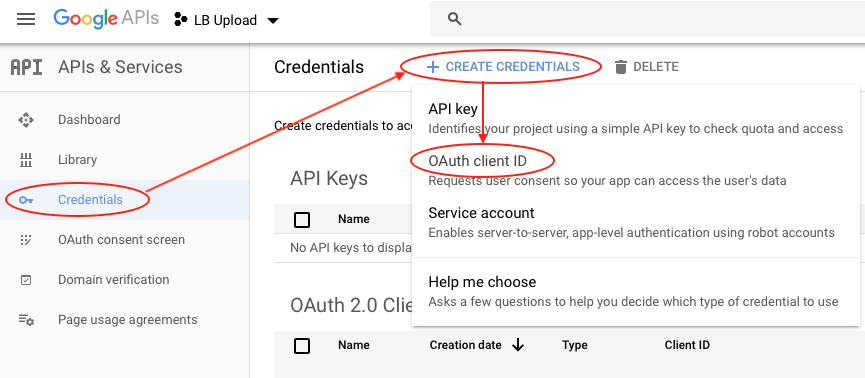
Step 5:
Now that you have YouTube credentials (Client ID and secret code), download the file containing them by clicking the “DOWNLOAD JSON” button on the top of the page or the arrow down icon. Finally, go to Live Blog (see below), choose any blog you’ve created there (see below) and click “ADD CONTENT HERE”, select “Video”, then click “UPDATE CREDENTIALS” and follow the directions to upload the JSON file you downloaded.
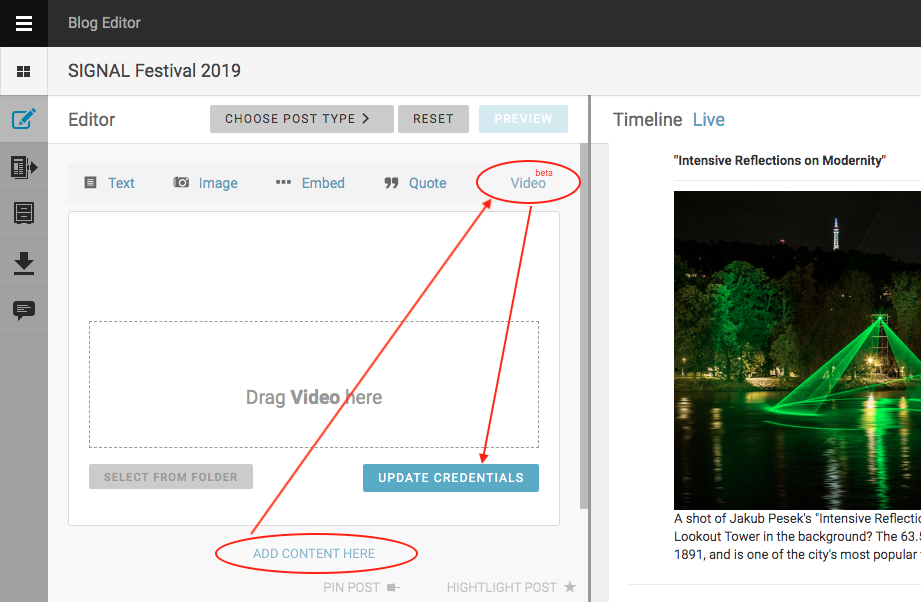
And there you have it. Now, when you post a video to your timeline by dropping it into the “Drag Video here” zone (above), it will be automatically uploaded to your YouTube account.
If you are not yet a Live Blog user and you’re looking for live blogging software to cover real-time news, you can try Live Blog for free here, no strings attached.
January 23, 2020
Guide to Live Blogging: Everything you need to know

Guide to Live Blogging: Everything you need to know
by Greg Bruno | September 20, 2024
In today’s news cycle, there’s no time for down time: live blogs are one of the best ways to deliver information quickly. But what, exactly, is live blogging, and what are live blogs good for, and which live blogging tool should you use? Good questions; here are some answers.
What is a live blog, anyway?
A live blog, sometimes referred to as “live text,” is a blog post that provides a rolling textual coverage of an ongoing event supplemented with images, videos, and other digital material. According to The Guardian: “Live blogs provide commentary and analysis alongside breaking news rather than summarising the event after it is over. It’s a transparent format in which the writers are able to update and amend their commentaries in easily digestible paragraphs.”
Live blogging can be used for a wide variety of events and circumstances – such as sporting events, elections, concerts, award ceremonies and conferences. Although live blogs are constantly evolving, news organisations use live blogs for a number of reasons: to reach wider audiences, to increase the transparency of the traditional news-making process, to increase content engagement, and even to generate new streams of revenue through blog syndication.
Live blogging through the ages
What started in the mid-2000s as a software tool for techies to broadcast technology conferences has since become an essential story format for journalists and other information providers to distribute digital coverage in chronological order.
Personalisation is a live blog’s comparative advantage. Unlike television, which must be watched in a linear way and in real time (although viewers can record it and watch it later), live blogs allow readers to start at any point in the story and reread, save, share, and digest information at their own pace.
Why live blogging?
Live blogs are widely read. In 2012, research by City University London found that live blogs get 300% more views and 233% more visitors than conventional online articles on the same subject. Live blogs also outperform online picture galleries, getting 219% more visitors. In 2013, the Reuters Institute for the Study of Journalism found that readers increasingly prefer live blogs to static content and believe live coverage to be more balanced and neutral. Additionally, 62% of survey takers said live blogs are the best format to consume news at work.
More recent data shows that audiences are spending less time reading full news stories and more time engaging with highlights and breaking news – everything from Steph Curry’s three-point buzzer beater to coverage of natural disasters. In fact, when big news breaks, studies show that readers actively seek out quality information through online search – before content is shared on social media. That’s one reason why having a live blog dedicated to breaking news coverage will boost your site’s profile online.
But the benefits are not limited to the immediate time during and after an event. It turns out that readers go back, again and again, to visit live blog timelines of events in the past. “Our experience is that live blogs drive lots of traffic to our site,” said Sybille Klormann, an editor at Zeit Online covering politics and economics. “We are often surprised at how many people visit these blogs, especially during elections, but also show a continued interest afterwards.”
Bottom line: “Live blogging can be a very valuable resource to your readers if done right,” says professional blogger Cameron Chapman. “If you take the time and keep focused throughout an event to provide useful information to your readers, they’ll often consider your blog the go-to place for event coverage in your industry. If it’s done poorly, though, all those blog posts will likely just be looked at as filler or fluff by your readers, and may even annoy some to the point they unsubscribe from your RSS feed.”
Proven use cases for live liveblogging
Live blogs can be used for covering a wide-array of news stories and banner events – as breaking news, elections, esports, conferences, award shows, and live sports. But even the most niche topics can find an audience with a well-done live blog.
Aleks Vickovich, wealth and legal managing editor at Momentum Media in Australia, says one company publication, ifa (Independent Financial Adviser) used a live blog to cover two weeks of financial hearings in 2018. As a result, ifa saw its new traffic increase by 200%. For a publication with “an extremely niche audience of hard core fans,” Vickovich said the growth made possible with live blog was staggering. “We had something like 60,000 unique visits in the two-week period, which is about twice what we usually get in a month.”
Part of that success is because live blog content is becoming more visible in web searches. Why does this matter? Because when the text of a live blog post appears as native content to search engines, it raises the profile of that news organisation’s coverage in new web searches, and also helps with the site’s overall SEO (search engine optimisation). Live blogs provide fresh, relevant content and increase engagement – essentially, longer session durations – through real-time updates, both of which are important factors in enhancing a website’s search rankings. Additionally, integrating LiveBlogPosting schema can improve a live blog’s visibility by indicating that an article is connected to a live event, helping it stand out in search results.
How to live blog successfully
The Internet is full of tips on how to live blog properly, and it can be a challenge to cut through the digital noise. To help you make the most out of your live blogging activity, we’ve collated some of the best insights from across the industry:
Step #1 | Choose the right live blog software
First you need to pick a live blogging platform that serves your needs. Sourcefabric’s Live Blog is a powerful, professional open-source live blogging tool created for journalists and bloggers on the go. It includes rich media posts – like image slideshows and video streams – as well as custom post types and scorecards for covering sporting events.
Additionally, Live Blog offers easy ways to monetise your coverage with tools to integrate native or remote ads into your live blog’s timeline.
The platform also offers a mobile reporting app (Live Blog Reporter) that allows your live blog team to contribute directly from their mobile phones. The app is particularly useful for events such as protests, concerts, and music festivals, where reporters need to write their live blog on the go, unencumbered by bulky equipment.
Step #2 | Plan your coverage BEFORE you start blogging
Once you’ve got your live blogging software picked out, now you need to think deeply about your topic and your blogging strategy. Start by identifying topics that your audience cares about. Whether it’s an important political debate, a major sports match, or a significant cultural event, choose live blogging topics that align with your readers’ passions and interests. After selecting your topic, develop a strategic approach. Coming up with material ad hoc is not the best practice for maintaining a successful live blog. Even though events unfolding in real time often leave little to no opportunity to prepare, there will inevitably be in-between moments where not much is happening. During these times, it’s important for you to have relevant material prepared in advance, general knowledge on the topic you’re covering, and reliable contacts who can assist you.
Step #3 | Think in terms of editorial resources
Producing a good live blog requires people. Some practical questions to consider: is there enough staff available at that particular moment and are there reporters on the scene able to provide information, verify facts, as well as submit images and videos? If the answer is no, perhaps a live blog isn’t the correct format.
Step #4 | Build in communication and collaboration tools
Using established lines of communication is essential for a time-sensitive format like live blogging. If you have a team of more than one, how will you share information about the blog’s content? Whether it’s a tool like Slack or email, you’ll need a way to exchange ideas and content before it’s posted.
Step #5 | Experiment
Because news consumers have taken a much greater interest in live blogs, the go-to form of storytelling offers endless opportunities for innovating. New organisations use live blogging for boosting audience engagement, increasing transparency in the news-production process, and even to generate revenue. There’s really no end to how a live blog can be deployed.
Live Blog examples
Below you will find a variety of live blog examples from around the web that best illustrate the potential of the format.
Der Tagesspiegel has been using Live Blog to provide continuous real-time updates on the Russia-Ukraine war. Their live coverage keeps audiences informed on breaking news with minute-by-minute developments throughout the conflict, such as military operations, reactions from global readers, and interactive maps.
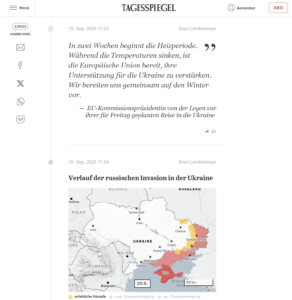
Tagesspiegel implemented Live Blog for real-time insights on the Russia-Ukraine war
Danmarks Idrætsforbund (the National Olympic Committee and Sports Confederation of Denmark) used Live Blog for the Paralympics to deliver real-time reporting of the event. They included a variety of social media content to make their coverage more visual and interactive for readers.

Danmarks Idrætsforbund used Live Blog for their Paralympics’ coverage
The Eurovision Song Contest used the Live Blog platform in the past to manage their live updates, incorporating social media and different forms of multimedia into Eurovision’s overall branding and corporate identity. The live blogging software efficiently handled tens of thousands of concurrent users, allowing the organisers to share highlights of the events and behind-the-scenes content without any technical issues.
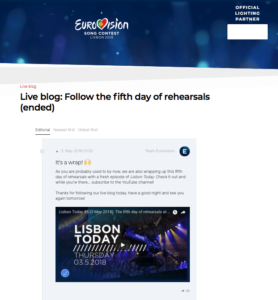
The Eurovision Song Contest’s live blog complemented their branding nicely
The M100 Sanssouci Colloquium is an international media conference held every year in Potsdam, bringing together representatives from traditional, independent, democratic media, alongside voices from politics and science, to discuss current socio-political developments and the media’s role in international affairs. They used Live Blog to provide real-time coverage of the conference, improving discussion and engagement by allowing digital participation and highlighting speaker quotes. The live blogging platform created an accessible, interactive experience for both online and on-site attendees.
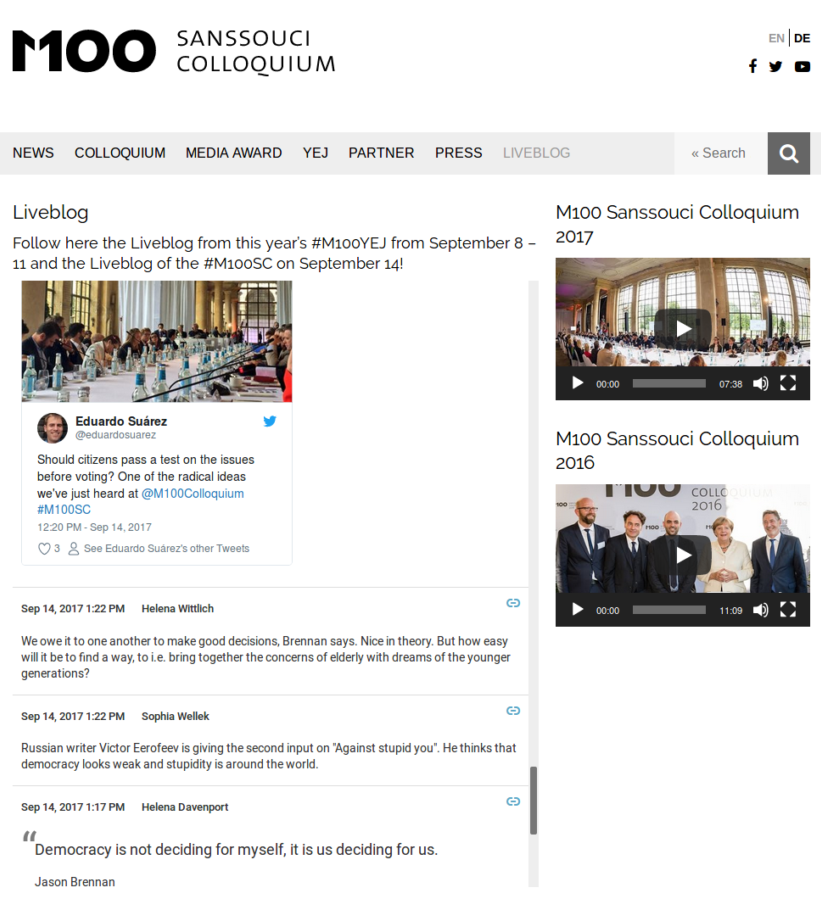
M100 Sanssouci Colloquium used Live Blog for their conference
Frequently asked questions about live blogging
How do I decide what to live blog about?
Select topics that happen in real-time and are of high interest, such as major sports or music events or breaking news. Watch out for trending topics and choose something relevant to your audience.
What makes a good live blog?
A good live blog provides timely updates, accurate and relevant information, and engaging content that keeps readers coming back. Consistent updates and interactive elements, such as polls or a comment section, can improve the overall experience.
How profitable are live blogs?
Live blogs can be profitable depending on different factors such as traffic volume and a good monetisation strategy. Revenue can come from native or remote ads, sponsorships, and premium content.
What are the best topics for live blogging?
Popular topics for live blogging include sports, such as the NBA or the Champions League, major news events, and notable entertainment events like the Oscars or the Eurovision Song Contest. Choose a niche with a broad fanbase and audience. Timeliness and relevance are key.
For Live Blog tutorials, check out our YouTube channel or our blog.
Editor’s note: This post was originally published in 2020 and has been updated in 2024 to include new, relevant insights and information.

